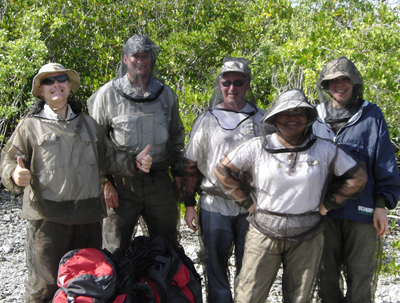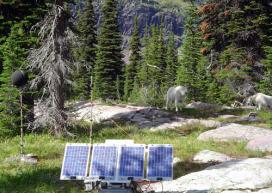Dispatch From the Field—Befriending Buffalo in the Badlands
"The worst experiences give you the best stories," said Cynthia Lee, an electronics engineer at Volpe, The National Transportation Systems Center. For over 20 years, Lee has been involved with many of Volpe's acoustics measurement projects, collecting, analyzing, and modeling acoustic data for over 40 National Parks to assess noise impacts from flights overhead (see sidebar for more).
Some projects are large and may involve more than 20 people. Other projects may involve only Lee and one other staff person. Whatever the project, there are two constants: the data must be collected and the wildlife must be avoided, if possible.

Volpe staff at Biscayne National Park in South Florida, preparing to collect important noise data. From left to right: John MacDonald, Clay Patton, Keith Lusk (FAA sponsor, Western-Pacific Region), Cynthia Lee, and Lelaina Marin (National Park Service [NPS] sponsor, NPS Natural Sounds and Night Skies Division). (Volpe Center Photo)
"The best you can do is be prepared," said Lee. "We've had rodents eat through our cables and bears claw at our devices." Lee has worked in 95-degree heat and 95 percent humidity in the Florida Everglades, where she and her team have had to sidestep alligators and snakes in order to obtain the data needed to run their noise models.
"Chris [Scarpone, a teammate] and I were in the Badlands [National Park, in South Dakota], and it was pretty scary at some locations because we were doing nighttime measurements," said Lee. "We would open the door to our vehicle, and all you would hear were the snores of the buffalo in pitch-black darkness." No stranger to the wilderness, Lee was still awed by the desolate nature of the Badlands. "Most sound measurement systems go down to about 20 decibels, but sometimes we use systems that can measure down to 0 decibels, which is approximately the threshold of human hearing. At that point, you can hear the blood flowing through your ears. The Badlands at night would get that low."
It was while in the Badlands that Lee encountered an overly friendly buffalo. "I stepped out of my car with the equipment, and there he was, at the head of my trail. I figured I'd wait him out, and he'd eventually move on, which he did," said Lee. "But when I got on the trail again, he'd come back again and then started following me. I started walking faster, and he would speed up too. Eventually I gave him the slip by running behind a tree until he lost interest."
Working in the wilderness to collect acoustics data can certainly prove challenging. "It's a lot of hard work and isn't for the faint of heart," said Lee. "It takes a particular type of person who will be able to lug 40 pounds of equipment through extreme weather and to hike out 5 to 10 miles a day. Death Valley [where we have worked] was over 100 degrees at times."
"It definitely takes a certain person, but you do it because you love it," said Lee. "I feel that what we do makes a difference in people's lives."
Her dedicated team has worked for 16 to 20 hours straight to capture the necessary data. "There's no regular schedule when you're out in the field," she said. "You just have to be flexible and willing to be prepared for anything. We only get one chance to collect the data."
Once they obtain their field data, the staff in Volpe's Center for Environmental and Energy Systems uses those data to predict potential noise impacts from air tours. The Integrated Noise Model, developed by Volpe on behalf of the Federal Aviation Administration (FAA), allows Volpe to establish the benchmark noise conditions for different parks and assess whether conditions have worsened or improved. Volpe experts then work together to advise the FAA and NPS on effective measures to mitigate or prevent adverse impacts of aviation noise on the natural and cultural resources, visitor experiences, and tribal lands within the National Parks.

Mountain goats investigate Volpe's sound measurement equipment in Glacier National Park, Montana. (Volpe photo)
Volpe and the National Park
Volpe staff work together with our sponsors at the National Park Service to accomplish a multitude of goals. Whether they are developing an alternative transportation plan to accommodate the numerous visitors to these natural treasures, alleviating congestion in popular getaways, or monitoring levels of aircraft noise to help preserve park visitors' experiences, Volpe's staff are integrally involved in projects all over the United States.
Cynthia Lee is involved in the Air Tour Management Plan project, a joint project between the Federal Aviation Administration and the National Park Service to mitigate or prevent adverse acoustic impacts in our National Parks.
